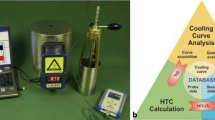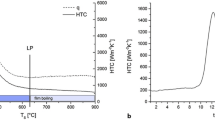Conclusions
-
1.
In place of sprayer cooling we propose quenching with a water-air mixture sprayed through a centrifugal sprayer. Use of water-air quenching excludes rejects due to cracking and sharply reduces the warping of flat parts.
-
2.
Sprayers should be placed above and below the piece. To obtain cooling at the same rate on the lateral surfaces the pressure of the mixture below the piece should be higher than above it. The following pressures were tested: 14.7·104 Pa above and 19.6·104 Pa below or 19.6·104 and 34.3·104 Pa, respectively.
-
3.
The synthetic quenchant Aquaplast can also be used with centrifugal sprayers.
-
4.
In quenching with a water-air mixture and aqueous solutions of Aquaplast it is possible to obtain different cooling rates by a combination of the pressure of the mixture and position of the sprayer.
Similar content being viewed by others
Literature Cited
Ya. I. Spektor and A. P. Grachev, “Some characteristics of cooling in a water-air mixture during induction hardening,” Metalloved. Term. Obrab. Met., No. 3, 35 (1962).
D. V. Budrin and V. M. Kondratov, “Water-air cooling during quenching,” Metalloved. Term. Obrab. Met., No. 6, 22 (1965).
Yu. G. Éismondt et al., “Cooling capacity of a water-air mixture obtained in a centrifugal sprayer of the F-1 type,” in: Heat Treatment of Metals [in Russian], Metallurgiya, Moscow, No. 5, 132 (1976).
S. N. Polyakov et al., “Selection of sprayers of the optimal design for cooling structural shapes,” Metall. Gonorudn. Promst., No. 4, 40 (1967).
L. V. Petrash, Quenchants [in Russian], Mashgiz, Moscow-Leningrad (1959), p. 112.
D. V. Budrin and V. M. Kondratov, “Use of heat probes of prismatic shape to determine the cooling capacity of quenchants,” Izv. Vyssh. Uchebn. Zaved., Chern. Metall., No. 4, 134 (1966).
Additional information
S. M. Kirov Ural Polytechnic Institute, Ordzhonikidze Ural Heavy Machine Construction Factory. Translated from Metallovedenie i Termicheskaya Obrabotka Metallov, No. 11, pp. 43–45, November, 1980.
Rights and permissions
About this article
Cite this article
Éismondt, Y.G., Shustov, A.V., Pil'shchikov, E.F. et al. Production and application of liquid-air quenchants. Met Sci Heat Treat 22, 832–835 (1980). https://doi.org/10.1007/BF00779438
Issue Date:
DOI: https://doi.org/10.1007/BF00779438




